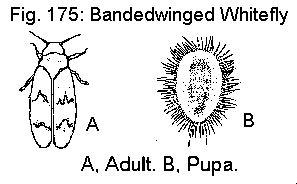
Adult- Mature adult bandedwinged whiteflies have zig-zag bands across the front pair of wings. The hind pair of wings are unmarked. With the exception of the front banded wings this whitefly is very similar to greenhouse whitefly.
Egg- The eggs are about 0.12 mm long and 0.10 mm wide. Eggs are placed randomly or in circles on the leaf underside. Newly deposited eggs are pale yellow and turn pale pinkish just before hatching.
Nymph- Young nymphs are 0.37 mm long, and as nymphal stages progress become just over one-half mm long. They are translucent white, with a yellow spot on each side of the abdomen. When the first instar nymph first settles down it begins to secrete a wax fringe that will become the side walls of the pupal case. As growth occurs the nymphal stages will secrete a marginal fringe of translucent setae, and the dorsal medial area of the integument becomes brown.
Pupa- The pupal case is just short of 1 mm long and 0.5 mm wide. The translucent marginal setae are of two lengths and the marginal palisade of wax rods is very distinct. The dorsal medial region is dark brown and uneven; the operculum is yellowish brown.

Fig. 175: Bandedwinged Whiteflies, Trialeurodes abutilonea (Haldeman), Aleyrodidae, HOMOPTERA
A, Adult. Adult with gray bands across the wings.
B, Pupa. Pupal case with a dark area along the back.
Hosts- Originally described on Abutilon theophrasti, but is now considered a polyphagous feeder. Some common weed hosts are Ambrosia, Bidens, and Sida. Some important ornamental hosts include Euphorbia (poinsettia), Geranium, Hibiscus, and Petunia.
Damage- Infested plants become chlorotic and unthrifty from sap removal. Honeydew and sooty mold also detract from the aesthetics of the crop. Unless controlled, bandedwinged whitefly can be very damaging to a floriculture crop.
Life History- Bandedwinged whitefly reproduces much like the more studied greenhouse whitefly. Temperatures will greatly affect the time required for a complete generation. It is known that eggs will hatch in about 12 days at early April temperatures of a Kentucky greenhouse.
Controls after establishment of major infestations will be very similar for all whiteflies. Prevention of greenhouse invasion from outdoors in the fall will make controls much easier in late fall to early winter. Part of this prevention will have to involve sanitation with respect to weed hosts around the greenhouse, both indoors and outdoors. Also, the proper disposal of rejected and remaining infested plants in the fall is important.
Chemical controls will be similar regimens for nearly all whiteflies. Biological controls would perhaps be an important alternative on perimeter plants, and on plants that have a longer growing season. For specific chemical control recommendations, see your County Cooperative Extension publications on ornamental plant pests.
University of Florida/IFAS Reference to Pest Control Guides